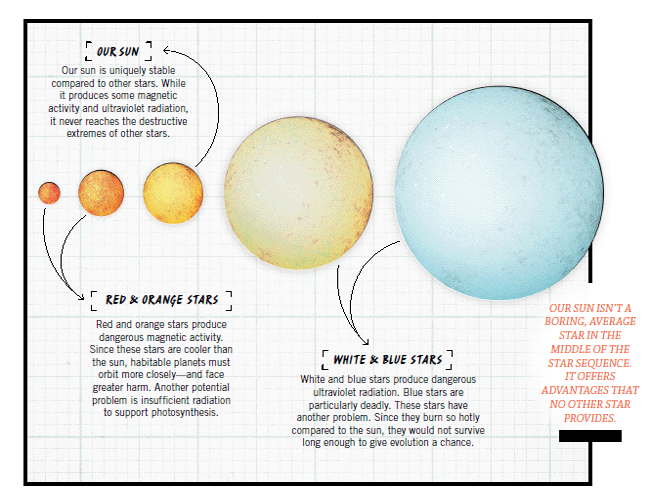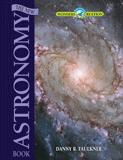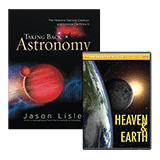Not Just Another Star
Special Feature: There’s No Place Like Home
“Our sun is just a tiny yellow star in a vast collection that could support life.” You’ll hear this more and more. Don’t believe it. The minimum requirement of a life-supporting star is missing from all the other stars. Our God-given sun appears to be unique.
Appearing bright from our perspective on earth, the sun obviously has a special status for us. But its brightness is impressive only because it lies so close compared to the stars. Given everything we now know about the brightness of other stars, it’s fashionable today to call the sun a star, even an average star. But is that really the case?
While the sun has many characteristics similar to stars, the Bible never refers to it as a star. This suggests that the sun may have some unique characteristics. Could that refer to its composition? The sun’s composition is a bit unusual—it has far less lithium than most stars do. Lithium isn’t very common in stars anyway, but the sun is among the most lithium-poor stars. Though this statistic is interesting, it isn’t clear whether it is significant.
The sun has another property that is very important and unusual—its stability. Astronomers have spent some time looking for stars similar to the sun, because such stars might be conducive to sustaining life on any planets that orbit them. Astronomers have found a few solar twins that have the same temperature, size, mass, and brightness as the sun, but nearly all of them are variable. That is, they vary in brightness. With all the concern about global warming today, it ought to be obvious that a constant sun is essential for life.
The sun may vary slightly in brightness, but it is beyond our ability to measure. So we can be confident that any normal variation is so small as to have few adverse effects on life.
In contrast to this, other stars (which are otherwise similar to the sun) typically vary in brightness by a few percent, with some varying far more. This would be disastrous for life on a planet orbiting such a star just from the standpoint of large temperature variations. Just one percent variation in the sun would result in an average temperature shift of 2°F (1°C) on earth. This may not sound like much, but this is change in the average temperature—local and seasonal changes likely would be far higher and more disruptive to life.
But there’s more than that. The variation appears to be related to magnetic activity, which can harm life. On earth we are familiar with the sun’s magnetic field because it is intimately involved with sunspots (or in the case of other stars, star spots). Every 11 years the number of spots and magnetic activity increase. During sunspot maximum, the sun frequently produces energetic flares that bathe the earth in an extra dose of particle radiation that can wreak havoc on earth and damage cells in living organisms. We can only imagine how destructive the radiation would be on planets orbiting other stars.

By God’s gracious design, the earth has a protective magnetic field that prevents the sun’s flares from disrupting life. The particles racing from the sun interact with the magnetic field, which deflects most of the particles. Yet we are periodically reminded about such imminent danger when the flares overload the ability of the earth’s magnetic field to protect us. Astronauts on the Space Station must enter protected sections of the station after a solar flare.
Not all planets have strong enough magnetic fields to protect living organisms on their surfaces. Even on planets that do, the situation would be dire if the star’s magnetic activity were far higher than the sun’s. The much more frequent and far more powerful flares probably would compromise any reasonable magnetic field that a planet would have. Because this particle radiation would be harmful to living things, even secular astronomers recognize that variable stars probably can’t support living things.
Secular scientists might respond that since we haven’t observed the behavior of stars for very long, we can’t prove just how unusual the sun is with respect to its long-term stable behavior. But it’s safe to conclude that all solar-type stars vary part of the time and are stable only part of the time. We live in a time of stability, but secular astronomers have no reason to believe this has always been the case. This stability throughout life’s history on earth is easy to explain if the sun and earth are young as we creationists know, but it wouldn’t work if the sun or any star system is billions of years old.
Life requires a stable sun at all times, and that’s just what God gave us.
Special Feature: There’s No Place Like Home
- Just Right for Life
- Not Just Another Star
- A Perfect Partner
- A Unique Blend
Answers Magazine
January – March 2014
Placed safely in our solar system’s “goldilocks zone” and engineered with the perfect balance of atmosphere, chemicals, and water, our earth was miraculously formed to be inhabited (Isaiah 45:18). This issue examines the earth’s unique suitability for life. We’ll also investigate what seminaries are actually teaching our pastors, the possibility that viruses could be beneficial, and more.
Browse IssueRecommended Resources

Answers in Genesis is an apologetics ministry, dedicated to helping Christians defend their faith and proclaim the good news of Jesus Christ.
- Customer Service 800.778.3390
- Available Monday–Friday | 9 AM–5 PM ET
- © 2025 Answers in Genesis






